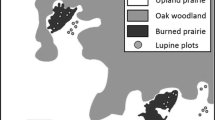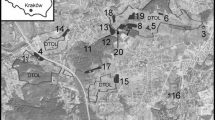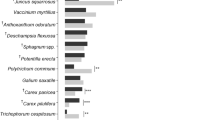Abstract
The ecological effects of fire management, especially regarding arthropods are poorly investigated. Burning in winter was assumed to pose a threat to butterfly species hibernating as larvae. To assess the impact of prescribed burning on population viability, we analysed larval-habitat preferences of the highly endangered, xero-thermophilous butterfly Hipparchia fagi in vineyards of the Kaiserstuhl region (southern Germany). Microhabitat preference analyses for mature larvae and egg-laying females revealed a preference of H. fagi for Bromus erectus-dominated communities with sparse vegetation coverage and a distinct tuft growth of the host plant B. erectus on microclimatically benefited slopes. We explain the preference of B. erectus by a preference of vegetation structure. The grass tufts offer a suitable climatically buffered living space for larvae. Egg deposition took place on dry substrate at positions of high solar radiation, thus adapted to hot and dry microclimate. As the larval habitat was sparsely vegetated as well as generally legally protected, fire management was not applicable and therefore not affecting the populations. We think it is conceivable that H. fagi, occurring here at its northern range limit, might expand its larval habitat into denser, combustible B. erectus stands in the course of global warming. A change in habitat preferences would necessitate a re-evaluation of management options.






Similar content being viewed by others
References
Alfred Töpfer Akademie für Naturschutz (ed) (1997) Feuereinsatz im Naturschutz. Schneverdingen
Anthes N, Fartmann T, Hermann G, Kaule G (2003) Combining larval habitat quality and metapopulation structure—the key for successful management of pre-alpine Euphydryas aurinia colonies. J Insect Conserv 7:175–185
Beneš J, Konvička M (eds) (2002) Motýli Ceské republiky: Rozšírení a ochrana I/II = Butterflies of the Czech Republic: distribution and conservation I,II. SOM, Praha
Bergman K-O (1999) Habitat utilization by Lopinga achine (Nymphalidae: Satyrinae) larvae and ovipositing females: implications for conservation. Biol Conserv 88:69–74
Bergman K-O (2000) Oviposition, host plant choice and survival of a grass feeding butterfly, the Woodland Brown (Lopinga achine) (Nymphalidae: Satyrinae). J Res Lepidoptera 35:9–21
Bink FA (1985) Host plant preference of some grass feeding butterflies. Proc 3rd Congr Europ Lepid, Cambridge, 1982, pp 23–29
Bink FA (1992) Ecologische Atlas van de Dagvlinders van Noordwest-Europa. Schutyt & Co, Haarlem
Bobbink R, Willems JH (1993) Restoration managements of abandoned chalk grassland in the Netherlands. Biodivers Conserv 2:616–626
Bolz R, Geyer A (2001) Zur Bestandessituation des Kleinen Waldpförtners (Hipparchia alcyone [D.S.] 1775) in Bayern. Schriftenreihe Bayer. LfU 156:355–365
Bourn NAD, Thomas JA (2002) The challenge of conserving grassland insects at the margins of their range in Europe. Biol Conserv 104(3):285–292
Brakefield PM, Shreeve TG, Thomas JA (1992) Avoidance, concealment, and defence. In: Dennis RLH (ed) The ecology of butterflies in Britain. Oxford University Press, Oxford, pp 93–119
Dennis RLH (1983) Egg-laying cues in the wall brown butterfly, Lasiommata megera (L.) (Lepidoptera: Satyridae). Entomol Gaz 34:89–95
Dennis RLH, Shreeve TG, Van Dyck H (2006) Habitats and resources: the need for a resource-based definition to conserve butterflies. Biodivers Conserv 15:1943–1966
Ebert G, Rennwald E (eds) (1991) Die Schmetterlinge Baden-Württembergs. Band 2: Tagfalter II. Ulmer, Stuttgart
Eichel S, Fartmann T (2007) Management of calcareous grasslands for Nickerl’s fritillary (Melitaea aurelia) has to consider habitat requirements of the immature stages, isolation, and patch area. J Insect Conserv. doi:10.1007/s10841-007-9110-9
Fartmann T (2004) Die Schmetterlingsgemeinschaften der Halbtrockenrasen-Komplexe des Diemeltales. Biozönologie von Tagfaltern und Widderchen in einer alten Hudelandschaft. Abh Westf Mus Naturkde 66(1):1–256
Fartmann T (2006) Oviposition preferences, adjacency of old woodland and isolation explain the distribution of the Duke of Burgundy butterfly (Hamearis lucina) in calcareous grasslands in Central Germany. Ann Zool Fenn 43(4):335–347
Fartmann T, Hermann G (2006) Larvalökologie von Tagfaltern und Widderchen in Mitteleuropa—von den Anfängen bis heute. In: Fartmann T, Hermann G (eds) Larvalökologie von Tagfaltern und Widderchen in Mitteleuropa. Abh Westf Mus Naturkde, Münster, pp 11–57
Fischer A (1982) Mosaik und Syndynamik der Pflanzengesellschaften von Lößböschungen im Kaiserstuhl (Südbaden). Phytocoenologia 10(1/2):73–256
Fleishman E (2000) Monitoring the response of butterfly communities to prescribed fire. Environ Manage 26(6):685–695
García-Barros E, Fartmann T (accepted) Oviposition sites. In: Settele J, Shreeve TG, Konvička M, Van Dyck H (eds) Ecology of butterflies in Europe. Cambridge University Press, Cambridge
García-Barros E, Munguira ML, Cano JM, Benito HR, García-Pereira P, Maravalhas ES (eds) (2004) Atlas de las mariposas diurnas de la Península Ibérica e islas Baleares (Lepidoptera: Papilionoidea & Hesperioidea) = Atlas of the butterflies of the Iberian Peninsula and Balearic Islands (Lepidoptera: Papilionoidea & Hesperioidea). Sociedad Entomológica Aragonesa, Aragonesa
Geyer OF, Gwinner MP (1968) Einführung in die Geologie von Baden-Württemberg. Schweizerbart′sche Verlagsbuchhandlung, Stuttgart
Hill JK, Thomas CD, Huntley B (1999) Climate and habitat availability determine 20th century changes in a butterfly’s range margin. Proc R Soc Lond B 266:1197–1206
Huntzinger M (2003) Effects of fire management practices on butterfly diversity in the forested western United States. Biol Conserv 113(1):1–12
Kahlert BR, Ryser P, Edwards PJ (2005) Leaf phenology of three dominant limestone grassland plants matching the disturbance regime. J Veg Sci 16:433–442
Kohler B, Gigon A, Edwards PJ, Krusi B, Langenauer R, Luscher A, Ryser P (2005) Changes in the species composition and conservation value of limestone grasslands in Northern Switzerland after 22 years of contrasting managements. Perspect Plant Ecol 7(1):51–67
Kudrna O (2002) The distribution atlas of European butterflies. Oedipus (20):1–343
Lafranchis T (2000) Les Papillons de Jour de France, Belgique et Luxembourg et leurs chenilles. Collection Parthénope, éditions Biotope, Mèze
Leopold P (2001) Schmetterlingszönosen ausgewählter Kalk-Magerrasen im Saale-Unstrut-Gebiet (Sachsen-Anhalt)—unter besonderer Berücksichtigung der Habitate des großen Segelfalters und der Berghexe. Diploma thesis, University of Münster, Germany
Leopold P (2006a) Die Larvalökologie des Waldteufels (Erebia aethiops) in Nordrhein-Westfalen und deren Bedeutung für den Erhalt der Art. In: Fartmann T, Hermann G (eds) Larvalökologie von Tagfaltern und Widderchen in Mitteleuropa. Abh Westf Mus Naturkde, Münster, pp 61–79
Leopold P (2006b) Larvalökologie der Rostbinde Hipparchia semele (Linnaeus, 1758; Lepidoptera, Satyrinae) in Nordrhein-Westfalen—Die Notwendigkeit raumzeitlicher Störungsprozesse für den Arterhalt. Dissertation, University of Münster, Germany
Moog D, Poschlod P, Kahmen S, Schreiber K-F (2002) Comparison of species composition between different grassland management treatments after 25 years. Appl Veg Sci 5:99–106
Müller-Westermeier G (1996) Klimadaten von Deutschland—Zeitraum 1961–1990. Selbstverlag des Deutschen Wetterdienstes, Offenbach
Porter K (1992) Eggs and egg-laying. In: Dennis RLH (ed) The ecology of butterflies in Britain. Oxford University Press, Oxford, pp 46–72
SBN (ed) (1987) Tagfalter und ihre Lebensräume—Arten, Gefährdung, Schutz. Fotorotar AG, Egg/ZH
Schultz CB, Crone EE (1998) Burning prairie to restore butterfly habitat: a modeling approach to management tradeoffs for the Fender’s blue. Restor Ecol 6(3):244–252
Settele J, Reinhardt R (1999) Ökologie der Tagfalter Deutschlands: Grundlagen und Schutzaspekte. In: Settele J, Feldmann R, Reinhardt R (eds) Die Tagfalter Deutschlands. Ulmer, Stuttgart, pp 60–123
Shreeve TG (1986) Egg-laying by the speckled wood butterfly (Pararge aegeria)—the role of female behavior, host plant abundance and temperature. Ecol Entomol 11(2):229–236
Steiner R, Trusch R (2000) Eiablageverhalten und -habitat von Hipparchia stalinius in Brandenburg (Lepidoptera: Nymphalidae: Satyrinae). Stuttg Beitr Naturkde A Nr 606:1–10
Stoutjesdijk P, Barkman JJ (1992) Microclimate, vegetation and fauna. Opulus Press, Knivsta
Swengel AB (1996) Effects of fire and hay management on abundance of prairie butterflies. Biol Conserv 76(1):73–85
Swengel AB, Swengel SR (2007) Benefit of permanent non-fire refugia for Lepidoptera conservation in fire-managed sites. J Insect Conserv 11:263–279
Thomas JA (1993) Holocene climate changes and warm man-made refugia may explain why a 6th of British butterflies possess unnatural early-successional habitats. Ecography 16(3):278–284
Thomas JA, Clarke RT (2004) Extinction rates and butterflies–Response. Science 305:1563–1564
Thomas JA, Rose RJ, Clarke RT, Thomas CD, Webb NR (1999) Intraspecific variation in habitat availability among ectothermic animals near their climatic limits and their centres of range. Funct Ecol 13(suppl 1):55–64
Thomas JA, Telfer MG, Roy DB, Preston CD, Greenwood JJD, Asher J, Fox R, Clarke RT, Lawton JH (2004) Comparative losses of British butterflies, birds, and plants and the global extinction crisis. Science 303:1879–1881
Tonne F (1954) Besser Bauen mit Besonnungs- und Tageslicht-Planung. Hofmann, Schorndorf
van Swaay C, Warren M (1999) Red data book of European butterflies (Rhopalocera). In: Nature and environment. Council of Europe Publ., Strasbourg
van Swaay C, Warren M, Lois G (2006) Biotope Use and Trends of European butterflies. J Insect Conserv 10(2):189–209
WallisDeVries MF, van Swaay C (2006) Global warming and excess nitrogen may induce butterfly decline by microclimatic cooling. Glob Chang Biol 12(9):1620–1626
Waltz AEM, Covington WW (2004) Ecological restoration treatments increase butterfly richness and abundance: mechanisms of response. Restor Ecol 12(1):85–96
Watt WB, Boggs CL (2003) Synthesis: butterflies as model systems in ecology and evolution—present and future. In: Boggs CL, Watt WB, Ehrlich PR (eds) Butterflies—ecology and evolution taking flight. The University of Chicago Press, Chicago, pp 603–613
Wiklund C (1984) Egg-laying patterns in butterflies in relation to their phenology and the visual apparency and abundance of their host plants. Oecologia 63(1):23–29
Wilmanns O, Wimmenauer W, Fuchs G (1974) Der Kaiserstuhl. Gesteine und Pflanzenwelt. In: Die Natur- und Landschaftsschutzgebiete Baden-Württembergs. Landesstelle für Naturschutz und Landschaftspflege Baden-Württemberg, Ludwigsburg
Acknowledgements
The investigations have been carried out in the framework of the research project “Ecological monitoring of the integration of prescribed fire in the management of vineyard slopes in the Kaiserstuhl area” on behalf of the Emmendingen Landscape Conservation Association (Landschaftserhaltungsverband Emmendingen), with financial support by the Ministry for Food and Rural Area Baden-Württemberg and the municipalities of the study area. We are very grateful to Norbert Hölzel for valuable comments that considerably improved the manuscript and to Lillian Harris for help with the English language.
Author information
Authors and Affiliations
Corresponding author
Rights and permissions
About this article
Cite this article
Möllenbeck, V., Hermann, G. & Fartmann, T. Does prescribed burning mean a threat to the rare satyrine butterfly Hipparchia fagi? Larval-habitat preferences give the answer. J Insect Conserv 13, 77–87 (2009). https://doi.org/10.1007/s10841-007-9128-z
Received:
Accepted:
Published:
Issue Date:
DOI: https://doi.org/10.1007/s10841-007-9128-z




